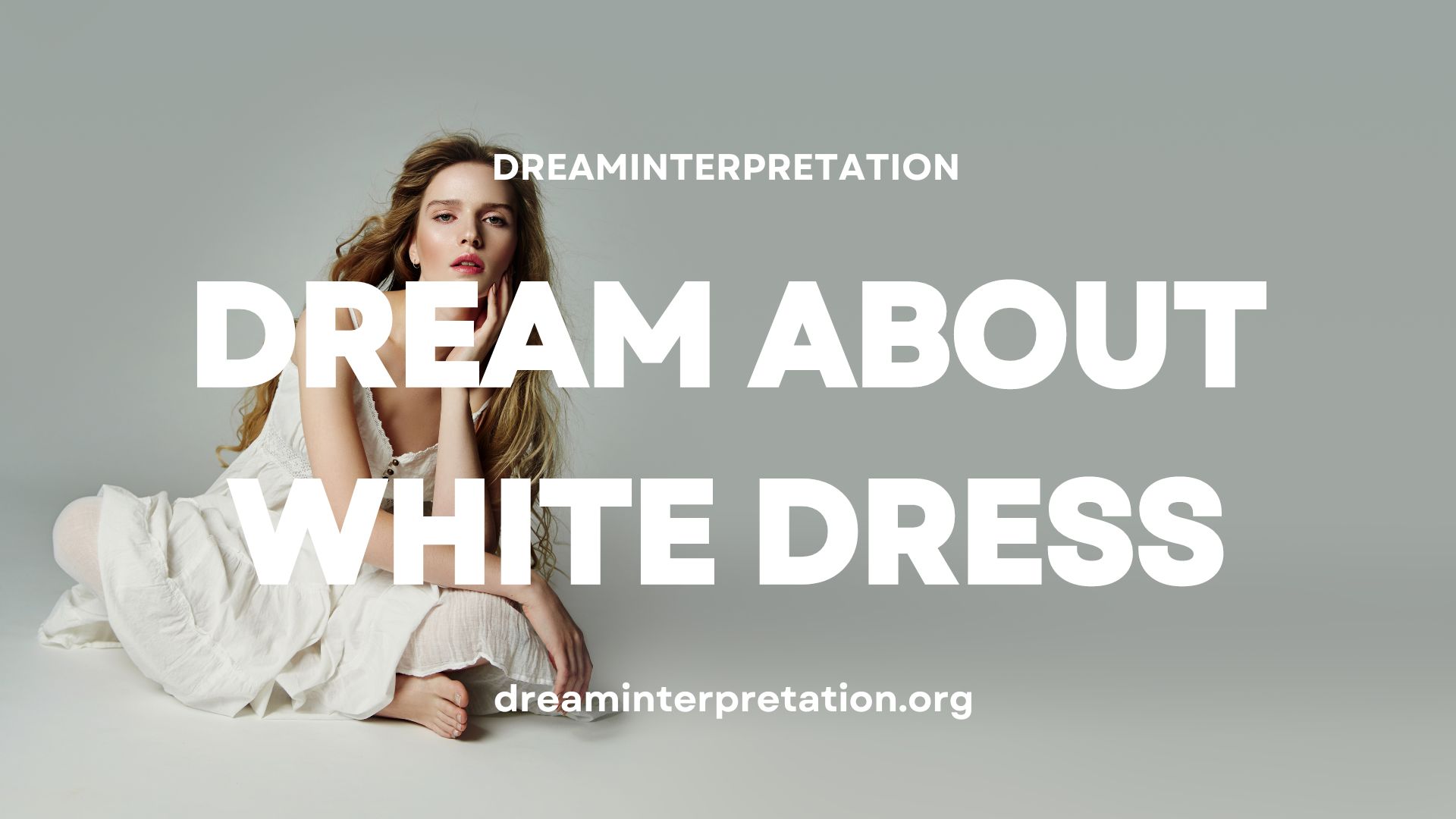The Hidden Meanings Behind Wearing a White Dress in Your Dreams – Could It Hold the Key to Your Desires?

Have you ever awoken from a heart-racing, question-filled dream? Dreams are captivating inner realms where reality and imagination intertwine. Today, we embark on a journey to uncover the hidden messages your subconscious sends through the white dress.
In this article, explore dream interpretation and discover the secrets within the white dress. Gain insights into your dream’s significance. Embrace interpretation for personal growth, healing, and transformation.
Dreams are a window into our desires, fears, and aspirations. Through symbols, they reveal untapped potential, unresolved issues, and hidden truths. Interpreting dreams involves understanding the significance of symbols like the white dress to gain self-awareness.
Understanding why a white dress appeared in your dream helps uncover its meaning. This symbol signifies purity, innocence, weddings, marriages, or personal transformation and new beginnings.
If you have ever dreamt of wearing a white dress or seeing someone else in one, its interpretation goes beyond just the surface. Understanding the hidden emotions, desires, and goals behind this imagery can bring clarity and inspire a fresh mindset.
Exploring the meaning behind your dreams empowers you with insights into your past, present, and future. Embrace this transformative journey of self-discovery as you interpret the enigmatic presence of a white dress in your dreams. Connect with your inner thoughts and desires to rejuvenate your life.
The captivating world of dreams, as we delve into the meaning of the white dress, will be explored here. Prepare to embrace personal growth, uncover hidden messages, and unlock the power of your mind through this magical journey into the world of dreams.
Dreams and Their Mysterious Nature

Dreams have long fascinated humans, as their enigmatic nature often leaves us pondering their meanings. The realm of dreams serves as a window into our subconscious minds and presents cryptic symbols and messages.
One aspect of dream interpretation is the symbolism of clothing. Whether it be a white dress, a tattered shirt, or a formal suit, the clothes we wear in our dreams can hold significant meaning.
Deciphering the symbolism of a white dress in dreams presents several possibilities. The color white often signifies purity, innocence, or spirituality. Therefore, dreaming of a white dress may indicate a desire for purity or spiritual growth, or it may represent innocence and freedom.
In order to fully understand the meaning of a dream featuring a white dress, one must analyze the context and emotions involved. The emotions associated with the dream can provide valuable insights into its interpretations. Ultimately, dreams defy simple explanations and remain an enigma. Exploring their symbolism can offer insight into our subconscious thoughts and desires, but the true meaning of a dream is subjective and unique to the individual experiencing it.
The Role of Dreams in Human History

Dreams have played a significant role in human history, shaping beliefs, influencing actions, and providing insight into the subconscious mind. Since ancient times, dreams have been intriguing and subject to interpretation, with many cultures attributing supernatural or divine powers to them. In various societies, dreaming was seen as a way to communicate with spirits, receive messages from gods, or glimpse into the future.
Dreams have been a source of inspiration and creativity throughout history. Many great discoveries, inventions, and works of art are believed to originate in dreams. For example, scientist Albert Einstein developed his theory of relativity after dreaming of sliding down a mountain. Composer Mozart created some of his best musical compositions based on dreams.
Throughout various cultures, dreams have also guided decision-making processes. In ancient Greece, dreams were seen as messages from the supernatural realm, offering advice or warnings. To understand the symbols and messages within their dreams, Greeks would seek help from experienced dream interpreters called oneirocritics and base their decisions on the interpretations.
Additionally, dreams have been used for therapeutic and healing purposes in numerous societies. Native American tribes, for example, viewed dreams as integral to healing physical ailments and maintaining general well-being. Indigenous healers would analyze the dreams of their patients to uncover the underlying causes of their illnesses and administer appropriate treatments.
The impact of dreams on human history is evident in literature and mythology. Countless myths, folktales, and epic stories from around the world revolve around dreams and the adventures they bring. The Epic of Gilgamesh, an ancient epic poem, uses dreams as catalysts for the hero’s journey and personal growth. Dreams serve as gateways to the unconscious mind, offering a deeper understanding of ourselves and our world. From ancient civilizations to modern societies, dreams shape our culture, beliefs, and actions. Whether spiritual messages, glimpses of the future, or vehicles for creativity, dreams continue to inspire and intrigue us.
Dreams have had a significant role in ancient cultures as a means of communication, allowing for dream interpretation. Furthermore, dreams have also been claimed as a source of inspiration for many important scientific discoveries and works of art.
Decision-making tools
Dreams were examined and interpreted for informed choices in ancient Greece by oneirocritics.
Healing and therapy
Indigenous healers analyzed dreams for insights into illnesses and treatment.
Literary and mythological
Dreams catalyze hero journeys and personal growth in numerous literary works.
White Dress in Dreams: Symbolism and Interpretation
A dream about a white dress carries symbolic meanings. It can symbolize purity, innocence, and a desire for simplicity in life. It can also represent a fresh start, suggesting the dreamer is ready for self-discovery and growth. Additionally, it can symbolize marriage or a commitment to a romantic relationship, reflecting the dreamer’s longing for love, companionship, and a harmonious partnership. The dream may also signify readiness for the responsibilities and challenges that come with commitment.
A dream featuring a white dress can represent spirituality and divine guidance. It may indicate that the dreamer is inclined or seeking enlightenment. The white dress serves as a reminder to stay faithful to one’s beliefs and values, encouraging the dreamer to explore the deeper aspects of life.
On the other hand, a white dress in a dream can also carry negative connotations. It may symbolize vulnerability or exposure, suggesting that the dreamer is struggling with insecurities or a fear of being judged. The dream might highlight the need to protect oneself emotionally and establish stronger boundaries in relationships.
The interpretation of a dream featuring a white dress depends on the dreamer’s personal experiences, emotions, and circumstances. While it symbolizes purity, new beginnings, and spiritual development, it is important to consider the context and associations within the dream to understand its meaning more fully.
Other Common Dream Symbols and Their Significance

Dreams are filled with symbolism, and understanding these symbols can provide insights into our subconscious thoughts. While white dresses symbolize purity, other dream symbols also have their own significances. Some examples include:
1. Flying: Dreams of flying are associated with feelings of freedom and empowerment. They may symbolize a desire to escape limitations or reach new heights in life. This dream can also represent a need for independence or a desire to gain a different perspective on a situation.
2. Water: Water in dreams can have various meanings depending on its form. Calm and clear water represents peace, clarity, and emotional stability. Murky or turbulent water may symbolize confusion, emotional turmoil, or unresolved conflicts. Water also symbolizes the unconscious mind and underlying emotions.
3. Falling: Falling dreams can be unsettling, indicating a lack of control or fear of failure in one’s waking life. These dreams give insight into areas of overwhelm or imbalance. They may also suggest a need to let go or relinquish control for stability and peace.
Animal encounters in dreams can have different meanings based on the species and context. For instance, a dream about a lion may symbolize strength, courage, or leadership, while a snake could signify hidden fears, deception, or transformation. Understanding the characteristics of dream animals can give us insight into the qualities and emotions we should address in our waking life.
5. Dreams about houses symbolize our state of being or represent different aspects of ourselves. For example, a large, grand house signifies success and accomplishments, while a dilapidated or haunted house suggests neglected or suppressed emotions. Exploring different rooms or the structure of the house in the dream may reveal hidden emotions or unexplored aspects of our personality.
(Dream interpretation is subjective and can vary for each individual. While these symbols and their significances can provide a starting point for analysis, it’s best to consider personal experiences, emotions, and intuition when interpreting dreams.)
Enhancing Dream Recall Using Techniques and Practices
Effective dream recall is vital for anyone interested in exploring the meaning and messages of their dreams. By improving your ability to remember and record dream details, you can uncover valuable insights into your subconscious mind.
One technique to enhance dream recall is maintaining a dream journal. By placing a journal next to your bed, you can quickly jot down dream fragments or images that come to mind upon awakening. This helps solidify memories and prevent them from fading. Regularly writing in your dream journal also trains your brain to prioritize recall, facilitating remembrance of future dreams.
Another practice to enhance dream recall is using affirmations and intent-setting before sleep. By repeating statements like “I will remember my dreams in vivid detail” or “I am a lucid dreamer” before bed, you set an intention for your brain to prioritize dream recall. This can create a mental atmosphere conducive to enhanced dream memory.
Improving sleep quality also contributes to better dream recall. Having a regular sleep schedule, minimizing disturbances in your sleep environment, and practicing relaxation techniques before bed can promote deeper, more restful sleep. Improved sleep quality lays the foundation for vivid dreaming and enhanced dream recall.
Finally, integrating practices like meditation or journaling into your daily routine can increase self-awareness and mindful living, which can also impact your dream state. By developing the ability to be aware of your thoughts, emotions, and actions while awake, you may become more skilled at observing and remembering your dreams.
To conclude, improving dream recall involves various techniques and practices intended to foster a deeper connection with your dream landscape. By regularly journaling your dreams, setting intentions before sleep, improving sleep quality, and developing self-awareness, you can enhance your ability to recall and learn from your dreams.
Analysing Symbols, Objects, and People in Dreams

Dreams commonly hold symbols, objects, and people with significant meanings. Interpreting these elements is key to understanding dreams. Symbols in dreams represent ideas or emotions. For instance, a white dress can symbolize purity, innocence, or a fresh start. The color white often signifies clarity and new beginnings. So if someone dreams of wearing a white dress, it may suggest a desire for a clean slate or an opportunity to start afresh.
Objects in dreams can hold meaning. A car, house, or piece of jewelry can give insights into subconscious thoughts and feelings. For example, a broken watch might indicate a fear of running out of time or unresolved issues. A functioning watch could symbolize a sense of control and punctuality.
People in dreams can represent aspects of the dreamer’s personality or their real-life relationships. For example, seeing a close friend in a dream might reflect a value or quality that the dreamer admires. Dreaming of an unknown individual could signify a part of the dreamer’s personality they need to explore.
Interpreting dreams requires a subjective approach, considering personal experiences, emotions, and associations. While there are general interpretations of common symbols, it’s important to explore each dream within the specific context of the dreamer’s life. Asking questions about emotions, relationships, and current circumstances can aid in understanding the rich symbolism in dreams.
Understanding Dream Themes and Patterns

Dreams, a mystery that has fascinated humans for centuries, can be filled with symbols, emotions, and scenarios. While dreams can seem random, analyzing themes and patterns uncovers subconscious insights. One common dream theme is the presence of objects like a white dress, which holds symbolic meaning. It can represent purity, innocence, or a desire for a new beginning.
Another important aspect of dream interpretation is recognizing patterns in our dreams. These patterns may include recurring themes, objects, or emotions. By noting these patterns, we can better understand our dreams and potentially uncover underlying issues in our waking lives.
Dreams also reflect emotional patterns that mirror our subconscious thoughts and feelings. For instance, recurring anxiety or fear may indicate unresolved traumas or anxieties that require attention. Conversely, recurring joy and peace can signal areas of contentment and satisfaction.
Unfortunately, interpreting dreams is not a one-size-fits-all endeavor. Dream dictionaries can offer general meanings for symbols and themes, but it’s important to remember that dream interpretation is highly personal. Every dream is unique, influenced by our individual experiences and subconscious.
In summary, grasping dream patterns and themes is key to uncovering hidden meanings. Through analyzing recurring objects, emotions, and patterns, we can gain valuable insights into our thoughts and feelings on a subconscious level. While dream interpretation isn’t a definitive solution, it can inspire self-reflection and personal development.
The Psychological Significance of Dreams

Dreams have long fascinated humans and experts alike, with countless theories attempting to interpret their meaning. Researchers from various fields, including psychology and neuroscience, have explored this subject in an effort to better comprehend the psychological aspects behind them.
Sigmund Freud, one of the most prominent figures in the field, theorized that dreams offer a glimpse into our unconscious minds. According to Freud, dreams allow repressed or denied desires, fears, and unresolved childhood issues to manifest symbolically. In his view, dreams fulfill a role in processing and distorting these unconscious urges.
Carl Jung, a prominent figure in dream interpretation, introduced archetypes as symbols that represent different aspects of human experience. These motifs help individuals tap into the collective unconscious and gain insights into self-discovery and development.
In psychology, dreams reflect emotional well-being and offer guidance for life challenges. Keeping dream diaries and analyzing dreams can foster self-reflection and personal growth.
Dreams play a significant role in our psychological landscape. They reflect our deepest desires, convey symbolic messages, and mirror our emotional state. Understanding their psychological significance can provide valuable insights into our subconsicous mind, enhance self-understanding, and guide life choices. Dreams are metaphors that help us determine actions and motivations, ultimately shaping our outcomes.
Using Dreams as a Tool for Self-Reflection and Decision-Making
The complex and mysterious nature of dreams often both perplexes and fascinates us, but there is more to them than initially meets the eye. Dreams can serve as a powerful tool for self-reflection and decision-making if we proactively engage with them and unpack their hidden insights. When we reflect on our dreams, we gain access to the depths of our subconscious mind. Dreams have a unique language that often communicates abstractly via symbols and metaphors. For example, dreaming of wearing a white dress might signify purity, innocence, or a transformative phase in one’s life. By noticing such symbolic details in dreams, we can gain a deeper understanding of our actions, motivations, and mental states.
The insights gained from dream analysis can guide our actions in waking life. Dreams can expose fears, desires, conflicts, and unresolved issues that impact our decisions and behavior. They offer valuable guidance and help us navigate life choices. By reflecting on our dreams, we can make informed decisions and align with our true selves.
Dreams are not a crystal ball predicting outcomes or choices. They provide insight into our subconscious, helping us analyze our inner world with respect to external circumstances. Dreams reveal patterns, enable connections, and offer various perspectives for decision-making.
Dreams possess invaluable insights for personal growth and decision-making. Reflecting on their symbolism taps into our subconscious mind, deepening self-understanding. Using dreams for introspection and analysis equips us to navigate life choices that align with our values and aspirations.
Finding Personal Insights and Inspiration from Dream Analysis
Dream analysis is the study of understanding the deeper meaning behind our dreams. This includes the interpretation of symbols, such as a white dress, providing insights into our subconscious.
Interpreting dream symbolism, like a white dress, depends on personal feelings and experiences. It can represent purity, innocence, or a bridal outfit. However, associations with purity may vary based on religious or cultural beliefs.
By analyzing dreams, individuals can gain a deeper understanding of themselves and their desires. Exploring symbols like a white dress can inspire self-discovery. Dreams provide insight into conflicts, aspirations, fears, and hidden desires. When interpreting the meaning of a white dress in a dream, consider the context and emotions. Was it worn by you or someone else? How did you feel when you saw it? Answering these questions brings clarity.
Dream analysis is subjective and should be viewed as a tool for personal introspection rather than absolute truth. Each individual brings their unique experiences and perspectives to the interpretation process. By embracing dream symbolism and engaging in self-reflection, one can uncover valuable insights that inspire personal growth and transformation.
Ensuring a Positive Dream Experience for Personal Transformation
Dreams possess a captivating power, serving as windows into our subconscious minds. They reveal dormant emotions, fears, desires, and hidden wisdom. But how can we maximize their transformational potential? How do we unleash their power?
The first step in ensuring a positive dream experience is to pay close attention to the symbolism and themes in your dreams. Just as a white dress represents purity and new beginnings, every element of your dreams carries significance. Decode these messages by reflecting on them, journaling about them, or discussing them with trusted friends or therapists – whatever works best for you. By doing this, you unlock a powerful tool for self-discovery and personal growth.
Establishing a bedtime ritual can help unlock the true potential of your dreams. Create a calm and distraction-free environment. Include activities like gentle stretches, meditation, or reading an inspiring book. Whisper affirmations as you fall asleep and intend to remember and learn from your dreams. These rituals connect your conscious and unconscious mind, facilitating meaningful insights during the night.
Dreaming is a powerful form of self-expression. Notice patterns and recurring symbols, explore archetypes and emotions in your dreams. Your dreams are unique to you, paying attention to their themes opens up self-discovery and transformation.
Reflect on insights from your dreams throughout the day. Find connections between your dreams and your waking life. Apply lessons from your dreams to grow as an individual.
Challenge yourself, overcome fears, pursue your desires.
Transform your dreams and incorporate them into your waking life, fostering personal growth and profound change.
Reflect on your most recent dream and take note of its key themes or symbols. Explore how these elements connect to your day-to-day existence. Share your insights in the comments below, and let’s learn from each other’s dream experiences to unleash the transformative power of our dreams and promote personal growth.
It’s time to embrace our dreams and seize the opportunity to truly transform our lives.


